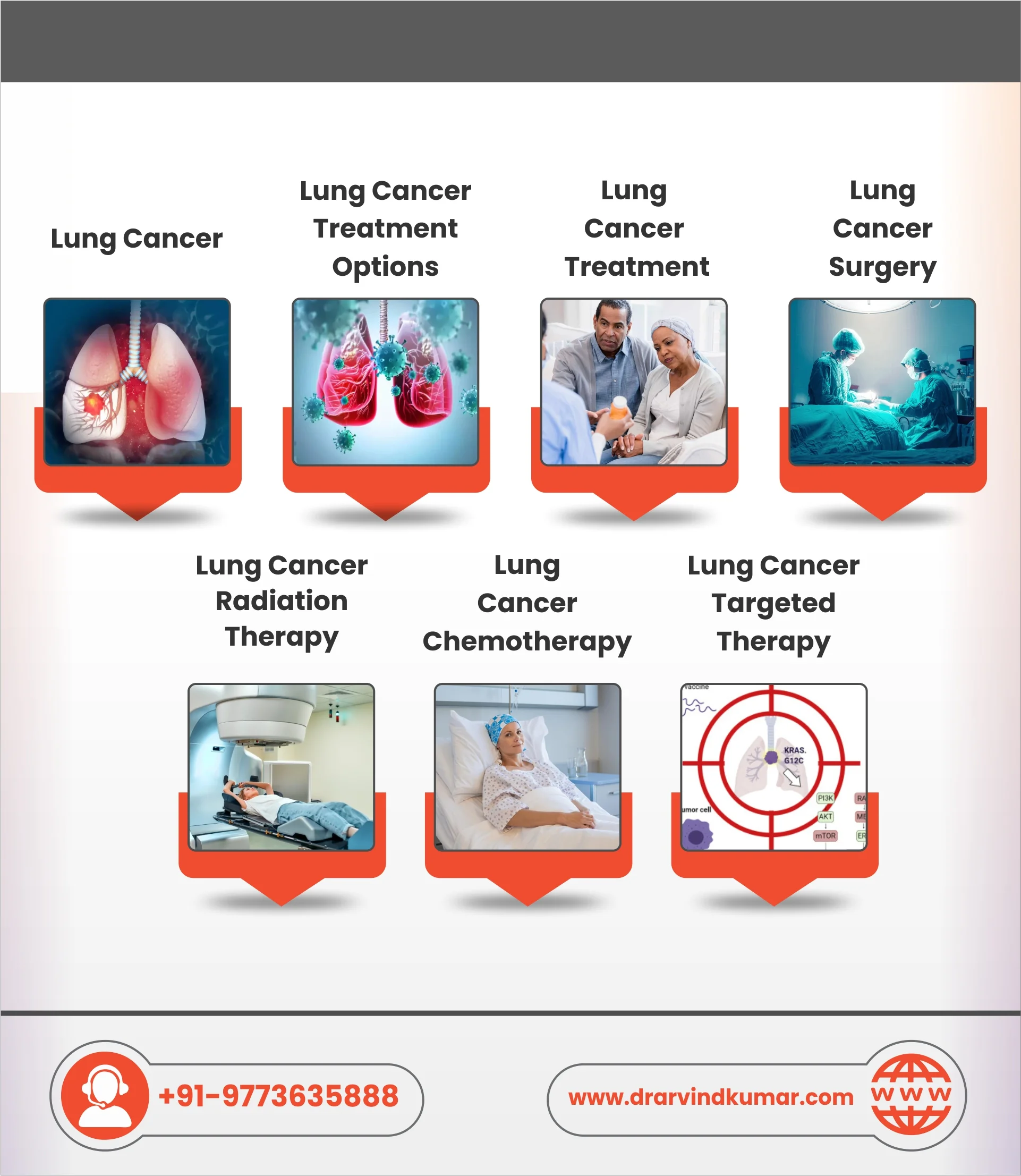Talking about lung cancer and the different lung cancer treatment options that are available may be confusing. Make sure you are aware of all your choices and any potential drawbacks before making any decision.
When selecting a treatment choice, you might find yourself asking, “What do I desire from my lung cancer treatment?”
Read on to learn the solution as this article discusses the various lung cancer treatment options so you can choose the best course of action for you.
Lung Cancer
The two most prevalent lung cancers are “small cell lung cancer” and “non-small cell lung cancer,” though there are other kinds.
Non-small cell lung cancer (NSCLC)
Non-small cell lung cancer is the most prevalent type of lung cancer. (NSCLC). It is the root of more than 80% of lung cancer instances. The two most prevalent types are adenocarcinoma and squamous cell cancer. Adenosquamous carcinoma and sarcomatoid carcinoma are two less prevalent types of NSCLC.
Small cell lung cancer (SCLC)
Small cell lung cancer (SCLC) develops more quickly and is more difficult to treat than NSCLC. It is frequently found as a comparatively small lung tumor that has spread to other areas of your body. Oat cell carcinoma and mixed small cell carcinoma are two distinct forms of SCLC.
Lung Cancer Treatment Options
All lung cancer treatment options have possible risks and side effects. You should consider all possible side effects when evaluating your options for lung cancer treatments. The majority of negative effects, however, are manageable.
After finding your lung cancer profile, your doctors will recommend one or a combination of the following lung cancer treatment options:
- Surgery
- Radiation Therapy
- Chemotherapy
- Targeted Therapy
- Immunotherapy
- Clinical trials
- Supportive/Palliative Care
- Complementary and Alternative Lung Cancer Therapies
Lung Cancer Treatment
NSCLC treatment can be sought in four different ways:
- Surgery
- Radiation therapy
- Targeted therapy
- Chemotherapy
Lung Cancer Surgery
During Lung cancer surgery, your surgeon removes the lung cancer and a portion of the surrounding healthy tissue. Techniques for removing lung carcinoma include:
A lobectomy is performed to eliminate one lungs lobe.
During the pneumonectomy procedure, the entire lung is removed.
To check for cancerous growth, your surgeon may also remove lymph nodes from your chest during lung cancer surgery.
Many of these surgeries are currently comparatively less invasive than earlier ones. Talk to your surgeon in advance about any possible adverse effects of the specific procedure you are having.
Additional treatments can be provided before and after your surgery to help lower the likelihood of recurrence. You might undergo neoadjuvant therapy, also known as induction therapy, before your lung cancer surgery. This type of therapy is used to treat the primary tumor, lower your chance of recurrence, and limit the scope of surgery.
Adjuvant therapy refers to medical care given after an operation. Any lung cancer cells that may remain in the body after therapy are to be eliminated. This lessens the risk of the disease returning, though there is always a possibility that it will.
Examples of these adjunct therapies used for NSCLC include radiation therapy and systemic medicines like chemotherapy, targeted therapy, and immunotherapy.
Before performing lung cancer surgery, your doctor might suggest chemotherapy or radiation treatment reduce a bigger lung tumor. If theres a possibility that cancer cells were left behind during surgery or if cancer could recur, your doctor might also advise chemotherapy or radiation therapy afterward.

Lung Cancer Radiation Therapy
In lung cancer radiation therapy, powerful energy beams from protons and X-rays are used to destroy cancer cells. As you lie on a table during radiation treatment, a machine rotates around you, directing radiation to particular parts of your body.
Lung cancer radiation therapy may be administered to patients with locally advanced cancer either before or after the operation. It is commonly given along with chemotherapeutic treatments. If lung cancer surgery is not possible, chemo and radiation therapy may be used instead.
Advanced and metastasized lung cancers may benefit from lung cancer radiation treatment to help relieve symptoms like discomfort.
Lung Cancer Chemotherapy
In lung cancer chemotherapy, powerful medicines are given to kill cancer cells. Chemotherapy drugs can be administered orally or systemically (straight into a vein). Several treatments using a combination of medications are often given over a few weeks or months, with intervals in between to allow for recovery.
Lung cancer chemotherapy is used to eliminate any cancer cells that might have escaped surgery. Additionally, radiation therapy can be applied concurrently. Chemotherapy can be given after surgery to shrink malignancies and make them simpler to remove.
Advanced lung cancer patients pain and other symptoms may be treated with lung cancer chemotherapy.
Lung Cancer Targeted Therapy
Lung cancer targeted therapy concentrates on particular abnormalities that exist in cancer cells. Targeted drug treatment stops these abnormalities, which kills the cancer cells.
Only patients with advanced or recurrent cancer are given the bulk of Lung cancer targeted therapy. Patients who can only profit from the administration of targeted therapy have specific genetic modifications in some cancer cells. In a lab, these altered cancer cells can be tested to determine whether these drugs might be helpful.
Conclusion
The type and stage of cancer, possible side effects, the patients preferences, and general health are just a few factors that influence the treatment and advice available. Research all of your lung cancer treatment options thoroughly, and make sure to get any questions answered. Together with your care team, decide on your lung cancer therapies. Although they are usually controllable, side effects are possible with all lung cancer treatments. You should talk with your doctor about the goals of each medication and what to expect during the course of treatment.
Frequently Asked Questions
Will my lung cancer recur?
The initial treatment method, the kind of lung cancer, and the stage at which it was discovered all affect the likelihood of lung cancer recurrence. While most instances of lung cancer recurrence are in the first five years post-diagnosis, there is, unfortunately, always a chance of recurrence.
What kinds of tests are there for lung cancer?
The low-dose computed tomography (CT) scan, which gives a detailed image of the lungs and uses only about one-third the radiation dose of a full-dose CT scan, is the only test for lung cancer screening currently authorized. It doesn involve injections or instruments and only takes a few minutes. A multidisciplinary teams assessment may follow positive screening tests, typically followed by additional scans and testing.

.webp)



